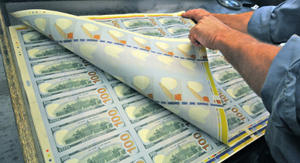Follow the moneyAudit finds lax security at money printing facility
The U.S. Treasury Department’s inspector general found that newly printed $100 bills were inadequately protected at Bureau of Engraving and Printing plants; about $54.4 million new $100 bills and $4 million uncut sheets of notes had “inadequate security” at a Bureau of Engraving and Printing (BEP) plant in Washington, D.C.; the production area in the Washington facility has over two dozen windows that lacked protective security features, and more than 200 employees have access to the area

Sheets of newly printed $100 bills // Source: cnet.com
The U.S. Treasury Department’s inspector general found that newly printed $100 bills were inadequately protected at Bureau of Engraving and Printing plants. The lax security measures were discovered during an audit. The audit report was released on Friday, 13 May.
Bloomberg News reported that about $54.4 million new $100 bills and $4 million uncut sheets of notes had “inadequate security” at a Bureau of Engraving and Printing (BEP) plant in Washington, D.C. A facility in Fort Worth, Texas, was also criticized for security issues.
The audit report found that the finished bills were wrapped in protective plastic but not stored in a locked cage. Some of the bills were found to be stored in the production area for more than nine months, even though the usual procedure is to move the finished bills to secure, limited-access vaults shortly after production. The production area in the Washington facility has over two dozen windows that lacked protective security features, and more than 200 employees have access to the area.
The audit, however, did determine that despite the security lapses, the money was safe. “After careful consideration, and based on multiple compensating controls, such as cameras, access control systems, locking mechanisms, etc., the BEP stored finished notes in highly secure space,” Bloomberg News quoted the Bureau.
